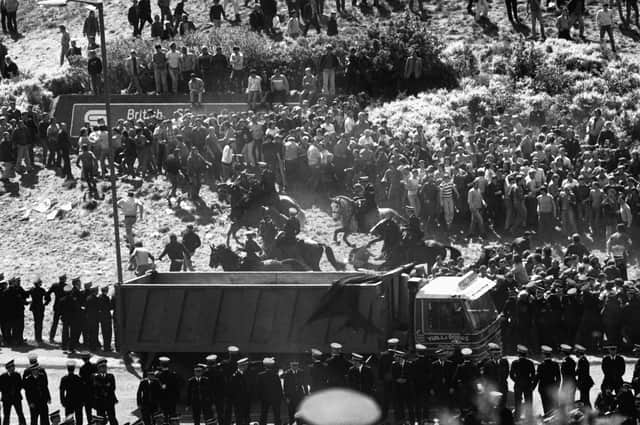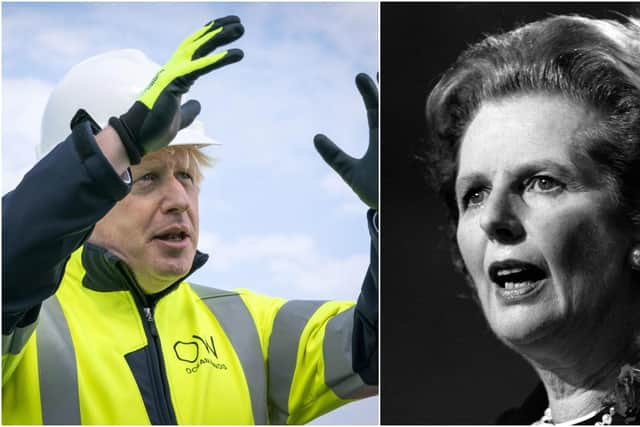The legacy of coalfield closures runs much deeper than the backlash to Boris’ gaff - John McLellan


He died at 76, not a great age but not bad, as most people would say. But a glance at the other headstones tell a very different story, because 76 was not just a great age for a miner but at the outer edge of life expectancy. Many of the miners in Horden Cemetery were dead long before their 65th birthday, their engines burnt out, as my father-in-law used to say, from emphysema, mesothelioma and heart disease.
He was indeed lucky: if it hadn’t been for a late shift swap he’d have been one of the 81 killed in the 1951 Easington Colliery disaster. The other man died. And it’s the men; the women usually lived far longer (my mother-in-law is still going at 87), so mining communities were full of sick middle-aged men pensioned off through ill-health and widows. Nobody wanted their sons to go down the pit but thousands did because there was little alternative.
Advertisement
Hide AdAdvertisement
Hide AdLike the men of the Durham Light Infantry and millions of others in the First World War, once the reality sank in very few wanted to be in the trenches and thousands died, but those who went were proud that they did. The last deep coal mine in Scotland closed in 2002, but there are still plenty of men around who will tell you proudly they were a miner before they tell you anything else about their working lives.


And so to yesterday’s front pages, dominated by Prime Minister Boris Johnson’s quip to journalists that his predecessor Mrs Thatcher put Britain ahead of the climate change curve with the pit closures of the 80s. Roundly condemned as “crass”, the story even led the Conservative-supporting Daily Telegraph and was an absolute gift for his many detractors in Scotland. But it’s unlikely to make much difference here when so many people already factor such throw-away buffoonery into their views. Less so in the old industrial heartlands of North England where the children and grandchildren of miners, with polished up Davy lamps sitting on the mantlepiece as a reminder of their heritage, now vote Conservative in their thousands.
No-one had heard of climate change at the time of the 1984 Miners’ Strike and the closures were all about the end of an uneconomic industry, where the cost of pumping out the flood water from miles of undersea tunnels far outweighed the value of the coal, and the determination of a militant union to keep them and its powerbase going. It was the speed with which closures took place and the lack of replacements which were the real problem, and had thousands of Nissan jobs been available in 1983, it’s a fair bet there would have been fewer pickets outside Monkwearmouth Colliery. Similarly, if Bilston Glen miners had been presented with a vision of the Easter Bush campus and the Roslin innovation centre then the future might not have seemed so bleak.
What matters now is what’s happening in those old industrial communities, and it is remarkable that pre-pandemic employment levels across the UK were better than in the supposedly mass-employment pre-Thatcher era, and with negligible inflation compared to the ruinous 1970s. But in some communities the sad truth is that the prospects for too many in places like North Lanarkshire, Inverclyde and many part of Glasgow are as poor as they were when the pits, steel mills and shipyards closed 40 years ago.
These are areas where industrial decline and higher unemployment go hand-in-glove with crime and drug abuse, and it’s no wonder First Minister Nicola Sturgeon leapt on Mr Johnson’s thoughtless gag because it was an opportunity to draw attention away from her own government’s appalling record of drug-related deaths which remains one of the most tragic symptoms of industrial decay. A 2017 report from Glasgow University and NHS Scotland drew a direct link between high unemployment in the early 1990s and drug-related deaths among young people because the number was steadily falling between 1979 to 1986 but rose with de-industrialisation. “The working class living in the de-industrialising regions, may have been particularly badly affected by these dramatic changes of the 1980s,” said the report.
It’s fair to assume the same factors would apply to all de-industrialised communities across the UK, yet data released on Tuesday showed that the number of drug deaths in England and Wales are a staggering five times lower than in Scotland. With 1,339 fatalities in 2020, the Scottish death rate is now 295 per million compared the UK’s 76, 43 in Ireland and just 18 in Holland.
The Dutch experience lends weight to the case for a more liberal approach to the continued criminalisation of drug abuse, but fatalities have trebled since the SNP took control of Scottish health, policing and justice in 2007, when Nicola Sturgeon was put in charge of health. Until 2019, Scottish Government spending on drug and alcohol services halved, and with identical drug laws it’s proof that the responsibility for the rising death toll lies squarely on the First Minister’s desk however much Nationalists try to blame Westminster.
Sure, the Prime Minister’s bad taste gag was a forehead-slapping moment for those of us campaigning under the Conservative banner, but it’s no more than anyone expects and will make as much difference to Scottish political opinion as the First Minister’s last-minute and half-hearted attempt to embarrass him with a Bute House invitation he was never going to accept. What matters is who has the responsibility to deliver and what’s happening now, so when it comes to talk about insensitivity to devastated post-industrial communities, the First Minister should start closer to home.
A message from the Editor:Thank you for reading this article. We're more reliant on your support than ever as the shift in consumer habits brought about by Coronavirus impacts our advertisers.
If you haven't already, please consider supporting our trusted, fact-checked journalism by taking out a digital subscription.
Comments
Want to join the conversation? Please or to comment on this article.
